The huge win here is that the carbon footprint of a wine bottle during production can range between 300-500g of CO2 and this total can be vastly reduced or eliminated by the use of a cork closure.
Ten years ago there seemed to be a huge shift away from corks and towards screw-caps. One reason for this is wine taint, or what many refer to as 'corked' wine, where a bacteria - Trichloroanisol - gives wine a damp cardboard aroma and destroys the wine's pleasurable characteristics.
Cork taint lost people money and also caused wine drinkers much disappointment. This paved the way for the rise of the aluminium screw-cap, which has been adopted on a huge scale in many of the world's leading regions.
In the period of the last decade, Portuguese company Amorim, the largest of the cork industry players, went to new lengths to detect the sources and eliminate cork taint. Today they use processes that clean the cork at various stages of the processing to reduce the risk. At the very top end, they have a technique known as ND Tech that guarantees the integrity of the cork.
Sustainability
However, it is fair to say that screw-caps have another ace up their sleeve - convenience. Not requiring extra tools like corkscrews obviously has benefits for those of us wishing to crack open a bottle of wine.
This has meant that many retailers generally hold shelves of wines that are interspersed with bottles with either screw-cap, cork closures, or worse still, plastic corks. Although it might not be a deciding factor, many people will express a preference.
There are vast differences in sustainability impact between corks and screw-caps, according to a previous study conducted by PWC. The whole lifecycle analysis carried out by PWC demonstrated that cork closures showed a 24-fold advantage over aluminium screw-caps.
Having looked at the life-cycle impact of cork against their competitors, Amorim hired Ernst & Young (EY) to conduct another independent study, this time looking at the true carbon impact of using cork closures. The findings released last week are quite a revelation.
This new study by EY finds that a single natural cork closure is proven to retain up to 309 grammes of CO2, while a sparkling wine stopper captures even more at 562 grammes.
Biodiversity
The huge win here is that the carbon footprint of a wine bottle during production can range between 300-500g of CO2 and this total can be vastly reduced or eliminated by the use of a cork closure.
The study goes beyond just offsetting the carbon equivalent of the glass bottle, it also highlights the importance of the 2.2 million hectares of native cork forests across seven countries in the Western Mediterranean basin – one of the world’s 35 biodiversity ‘hot spots’.
The cork forests are well known as a keystone species driving biodiversity in this region. With over 70 percent of cork usage going into wine closures, it could be argued that drinking wine sealed with cork has a material benefit in supporting this valuable carbon sink.
Carlos de Jesus, Amorim’s head of marketing & communications, said: “With such high levels of CO2 retention, our Amorim products are fast becoming the go-to partners for wineries around the world looking to deliver brands with a much more positive and sustainable impact.”
This Author
Nick Breeze is a climate change journalist & interviewer, an organiser of The Cambridge Climate Lecture Series, as well as writing on Envisionation.co.uk and SecretSommelier.com - follow on Twitter at @NickGBreeze.







